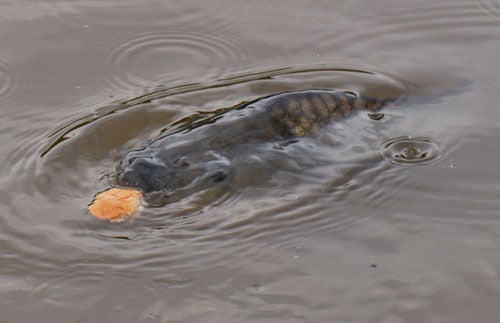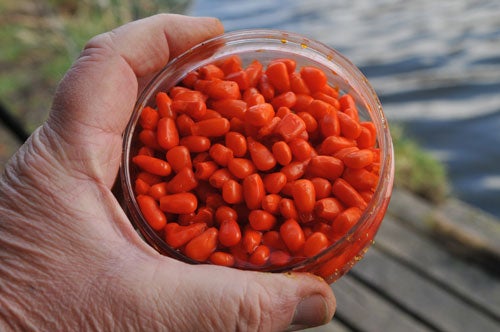Following an article by Jeff Woodhouse, ‘Bait Flavours and Tastes’ here’s one from me on a similar theme. It was originally published in Coarse Fisherman magazine early last year.
Carp and Nutrition RecognitionAlthough I’ve headed the following with the words ‘carp baits’ it generally applies to baits for all species. I’ve directed it specifically at carp because it is carp anglers who have pioneered the modern day thinking about baits and propounded the theories upon which modern baits and flavours are based. And for that we owe them a vote of thanks, for at the very least the theories are a basis upon which to launch a train of thought. Nevertheless, that should not, and will not, prevent me from questioning some of the theories that have now evolved into accepted ‘fact’ with many carp anglers.
One theory is that in the long term a carp can recognise the difference between a nutritious and a non nutritious food item. It is said that if a carp does not get what it needs, nutritionally, from eating, say, a boilie that is little more than flavoured stodge, it will have to go in search of other food items in order to supplement its diet. The conclusion being that if carp are offered a highly nutritious boilie they get all the nutrition they need from it and have no need to go in search of supplements; they will continue to feed on that particular boilie indefinitely. I don’t know enough about nutrition in fish or any other creature, including humans, to dispute that, but my knowledge of nutrition is no better or worse than that of most of those who continue to sustain the now accepted carp bait theories. But I’ve always wondered how fish can instinctively recognise all this nutrition, or lack of it, in a ball of man-made food, and yet we humans, supposedly the most intelligent creatures on this planet, need research scientists to discover what is nutritious, and labels on food to tell us if it’s any good for us. Almost every food package you pick up today carries a list of ingredients, E numbers and allergens. Shouldn’t we be able to instinctively recognise the good from the bad just like fish are supposedly able to do? Why do we need a label and they don’t? How is it that the human appetite is triggered solely by smell and taste to the point where a person will wolf down a bag of greasy chips but reject a stack of lettuce leaves that will (according to scientific research) do us far more good? And yet a carp can, according to what we’re told by the bait gurus, identify and avoid low nutritional food, then go off and search for other food that will supplement a poor diet. The theory says it does this only after eating the poor value food for some time, but nevertheless, that kind of nutrition recognition is beyond the capability of any human being that I know of.
I’m honestly not being facetious here, but I’ve always found the nutrition concept regarding carp baits hard to come to terms with. Some of it makes partial sense and some of it doesn’t; common sense that is. I understand that the carp’s feeding behaviour is a matter of instinct and that human feeding behaviour is, at least in the civilised world, research and label led, but that doesn’t explain why carp in a rich environment don’t just go and eat everything they fancy (just like humans) and become unhealthy lard arses like those of us who still eat according to smell, taste and appetite. Ah, but maybe they do! The majority of the biggest carp caught do look like unhealthy fat-gutted creatures; the equivalent to the human couch potato. Most of the big carp that anglers target have unnaturally fat, bloated guts that fly in the face of the theory that says carp have this marvellous natural instinct to recognise what food is good for it. So if this natural instinct is so good, good enough to recognise the difference between a ball of stodge and a ball of nutrition, why isn’t it good enough to tell the fish it is eating too much of something and getting too fat for its own good? Yes, I know this big gut factor is bred into them to some extent, but not entirely. “Perhaps it does know it is eating too much but ignores it, just like many overweight humans do,” the HNV bait expert may reply. OK then, so why doesn’t the carp ignore the instincts that tell it to reject a stodge boilie and scoff a HNV boilie? It just doesn’t make sense to me to believe that a carp instinctively rejects a poor food value boilie in favour of a nutritious boilie, but continues to eat to the point where it has an unnaturally fat gut. Either its eating instincts are highly tuned or they’re not; either those instincts are highly tuned and heeded, or they’re not. Something, somewhere, about this widely accepted theory regarding carp baits, just doesn’t add up.
It was following a conversation with Jeff Woodhouse about food factors, flavour and bait that inspired me to take another look at the latest findings regarding smell and taste in humans. I know that is, to some extent, a waste of time as it may have very little to do with what carp can smell and taste, but it’s no more a waste of time than the millions of words written about smell and taste in carp by laymen (anglers) who have nothing more to go on than what bait caught the most fish last year and maybe even the year before. To be fair, a few have gone into the topic in some depth and gathered as much information and evidence as they could, but most are just repeating what others have written. At least by looking at what we know about smell and taste in humans we’re dealing with facts and not mere conjecture, and if nothing else, it may give us a few clues where carp are concerned. Due to us becoming increasingly health and fitness conscious nutrition in humans is a current hot topic and there is an absolute mass of information about it. Go on the internet and you can easily spend a week doing nothing else but read about healthy food and nutrition and still only scratch the surface. The basic premise is this: the flavour of food is determined by a number of different factors including taste, smell, colour, temperature and general appearance. It had long been accepted that there were four basic tastes: sweet, sour, salty and bitter. But now we have a fifth element known as umami, a Japanese word meaning savouriness, and most specifically to the recognition of glutamates common in protein rich foods, monosodium glutamates (MSG), of course, long being used in Asian foods and the element that gives you the sensation of feeling hungry again just an hour after eating a generous Chinese meal. So what’s all that got to do with carp baits? Well, even where human nutrition is concerned we’re still discovering new things (umami for instance) about smell, taste and appetite and in many ways still only scratching the surface. So how can it be possible to draw so many of the many quite inflexible conclusions we have drawn about baits and flavours where fish are concerned when it’s obvious we know so little? Some anglers state that x ingredient is best in winter and y flavour is best when the sun sets on an October evening. Others say that flavours don’t make any difference; that it’s all about having a good base mix.
How do they know that? Short of fishing multiple rods in the same swim at the same time, pitching multiple baits, flavoured and non-flavoured, against each other for at least several years, can you draw a tentative conclusion. And even then changes in conditions and other variables will prevent any meaningful results. It’s all baloney! Very rarely do many of the statements made about baits include essential words such as ‘apparently’, ‘possibly’ and even ‘probably’. Oh no, it appears that many anglers think the popular bait theories are written in stone. Right, now let’s bring colour into the equation and see just how we automatically relate colour to taste and flavour. What colour is a pineapple flavoured boilie? Yellow of course, because pineapples are yellow aren’t they, so what else would they be? And yet most of the flavours used in foods, and especially in carp baits, are clear liquids. So why don’t the bait makers leave the boilie the natural colour of the base ingredients with the flavour of pineapple? Because colour is important, the bait maker will say, and colouring it yellow will enhance its appeal. Appeal to whom though; the fish or the angler? Most anglers will tell you that the colour red is the most appealing colour to most fish. And I wouldn’t argue with that, having caught my fair share of different species on red maggots, red boilies and other red baits. Most anglers will vote for red being a more appealing colour to fish than is yellow. Those same anglers will swear that pineapple flavour is one of the top flavours for carp. No question about it. So let me ask you this: why do we not have a pineapple flavoured boilie that’s dyed red? Have you ever seen one? No, neither have I. But why not? Are we pandering here to what colour humans associate with pineapples? And if so, why? Do we think that a carp may be visually attracted to a red boilie but turn away from it because it smells of pineapple and it’s not yellow? How many real pineapples do you think a carp comes across in a year; in a lifetime? Quite probably none. So on that reckoning it won’t know that a pineapple is yellow. In fact it won’t know that what it’s smelling is the essence of a pineapple. All it may know is that it quite likes the smell, and possibly the taste, of pineapple, even though it won’t know the identity of what it’s smelling and tasting.
But we don’t have any red boilies flavoured with pineapple. In fact I’ve never seen a yellow strawberry flavoured boilie. It’s all nonsense isn’t it? We haven’t moved on too far really from the early days of bottled carp flavours when one of my favourites, mainly due to the amusement factor, was called ‘Mown Grass’. Of course there must be elements of truth in the general carp bait theories, but what annoys me are the categorical statements made by some, just as though they know that what they’re saying is an actual fact. Some make statements that are downright laughable, where they would have had to have had a conversation with a carp, or been a carp in a previous life, to know if what they’re saying is absolute fact, or even close to being a fact. Moreover, everyone assumes that all carp behave the same, with the same preferences in taste and smell and colour. Isn’t it just possible that, like humans, individual carp have individual preferences, some liking sweet, some preferring savoury…….? Who knows? I certainly don’t. |
Welcome!Log into your account















